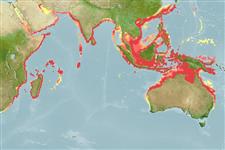Common names from other countries
Environment: milieu / climate zone / depth range / distribution range
Ecología
marino demersal; rango de profundidad 7 - 200 m (Ref. 4417). Tropical; 30°N - 35°S, 24°E - 154°E
Indian Ocean: throughout the region including the Red Sea and Persian Gulf; south to Algoa Bay in South Africa (Ref. 4417). Western Pacific: Taiwan southward to New Guinea and extending to the northeastern coast of Australia.
Tamaño / Peso / Age
Maturity: Lm ? range ? - ? cm
Max length : 37.5 cm TL macho / no sexado; (Ref. 117081); common length : 15.0 cm SL macho / no sexado; (Ref. 9774); peso máximo publicado: 760.00 g (Ref. 117081)
Espinas dorsales (total): 0; Radios blandos dorsales (total): 67-74; Espinas anales 0; Radios blandos anales: 52 - 66. Eyed side with dark rings arranged in about 5 longitudinal rows; dark blotch at junction of straight and curved parts of lateral line and 2 smaller ones on the lateral line at posterior part of body and anterior end of caudal peduncle; small dark spots and elongate markings on median fins; pectoral fins with 10-12 rays on eyed side, 10-11 rays on blind side (Ref. 4417).
Found on clay, sand and mud bottoms of the continental shelf. Feeds on benthic animals (Ref. 5213). Mainly sold fresh.
Life cycle and mating behavior
Madurez | Reproducción | Puesta | Huevos | Fecundidad | Larva
Distinct pairing (Ref. 205).
Nielsen, J.G., 1984. Bothidae. In W. Fischer and G. Bianchi (eds.) FAO species identification sheets for fishery purposes. Western Indian Ocean fishing area 51. Vol. 1. FAO, Rome. pag. var. (Ref. 3322)
IUCN Red List Status (Ref. 130435)
CITES (Ref. 128078)
Not Evaluated
Threat to humans
Harmless
Human uses
Warning: mysqli::__construct(): (HY000/1040): Too many connections in /var/www/html/includes/func_getlabel.php on line 46
Can't connect to MySQL database (fbapp). Errorcode: Too many connections
